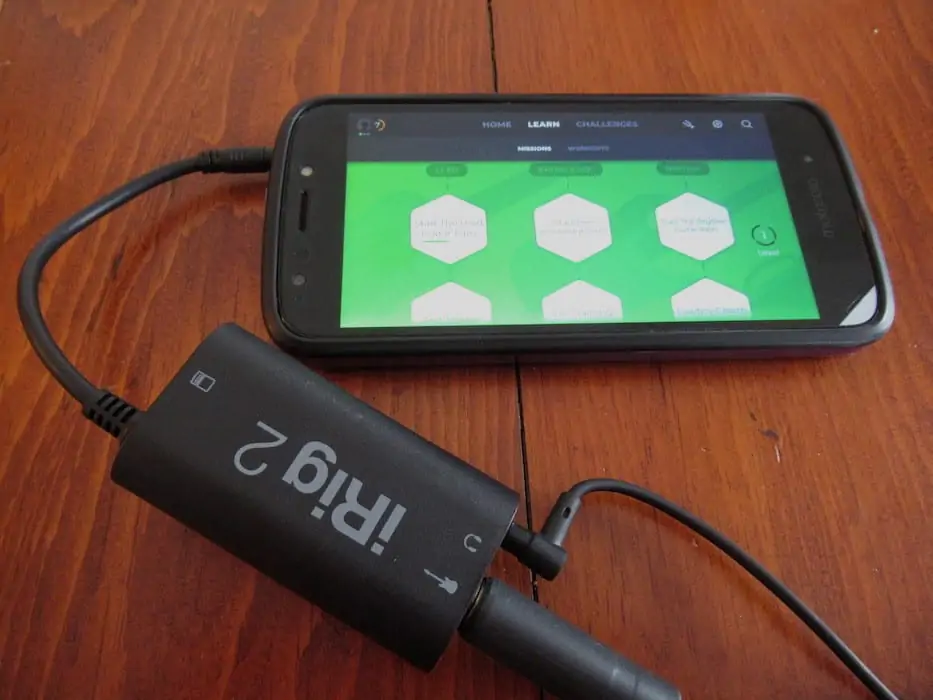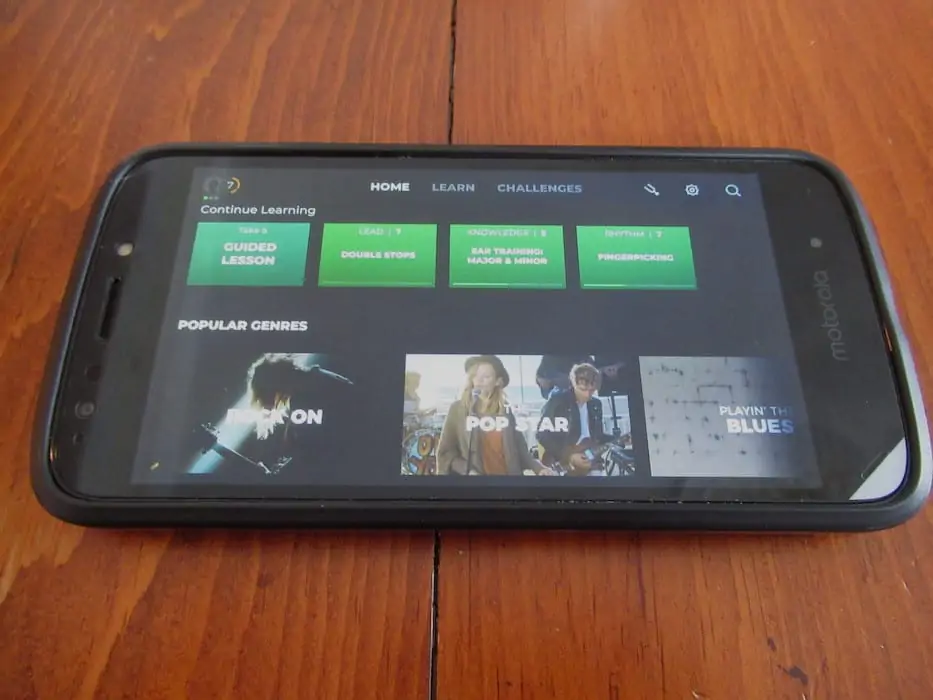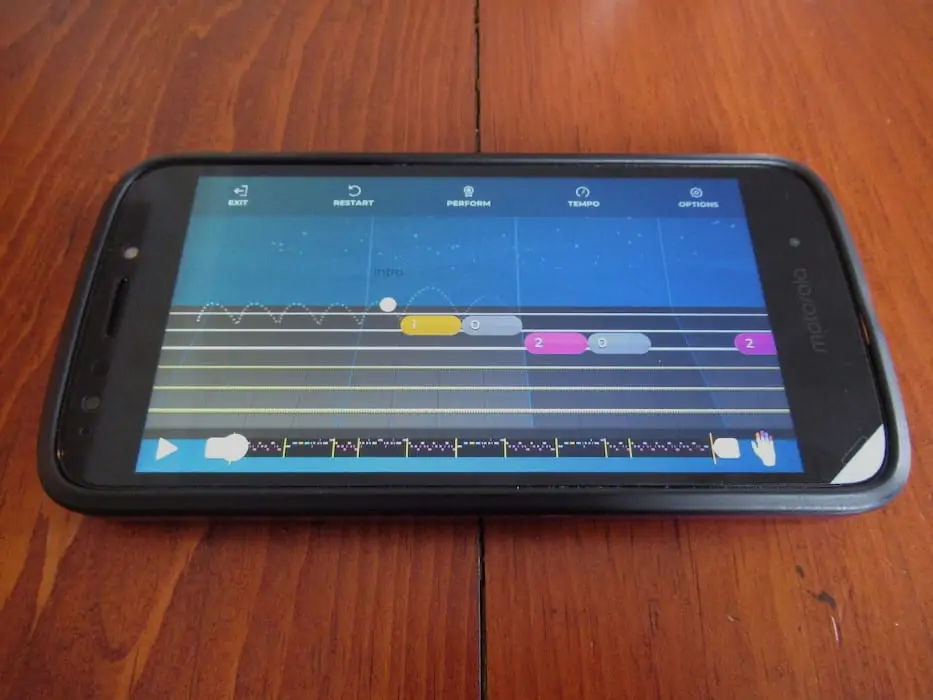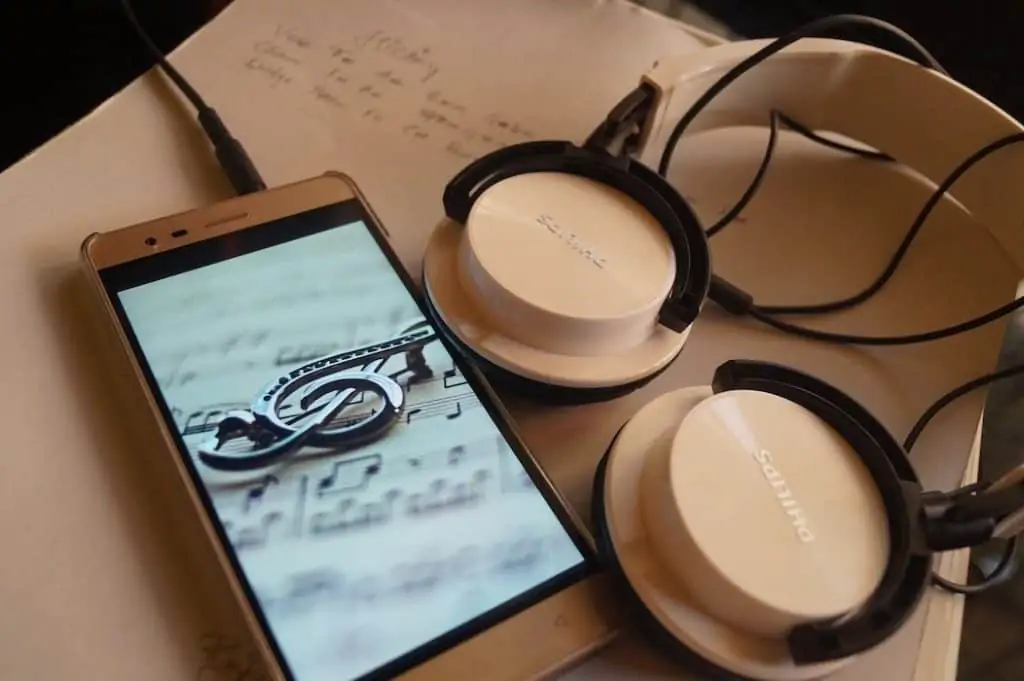Learning guitar shouldn’t be a chore. After all, it’s called “playing” for a reason! It should be just as fun as playing sports. Or better yet, video games….
Enter Yousician. This Finnish company first made waves in 2010 with their popular Guitar Tuna tuning app. Then, in 2014, they launched a music teaching app for iOS, Android, Mac and PC.
Unlike your typical platforms like Guitar Tricks and JamPlay, Yousician actually listens to you play. It also gives feedback on all your notes and chords. Kind of like the Guitar Hero and Rock Band games of yore. Only this time, you can swap the 4-button plastic Les Paul for a real acoustic or electric guitar.
It may feel like a video game. But Yousician has a serious mission –– to make musicality “as commonplace as literacy” (Cropped from “Yousician” by Sonanna7777 / CC BY-SA 4.0).
Yousician has a lot to brag about. 10 million+ downloads on Google Play and the Apple App Store. A 4.2/5 star rating on Trustpilot. Thumbs up from Guitar World and the New York Times.
But does it live up to the hype? It all depends on what you’re looking for…
This review is mostly based on the Android app (version 4.21.0). I also downloaded the iPad (version 4.22.0) and Mac desktop apps for comparison.
Contents
Getting Started
Once you download the app and create an account, you can start by selecting your instrument – guitar, ukulele, bass or vocals.
Then, in a short intro video, you’ll be asked what kind of things you can play:
- Nothing yet
- Some basics
- Lots of songs
- Almost anything
After tuning your guitar, you can start a quick lead and rhythm exercise based on your answer. Yousician uses your score to recommend a starting place. But you can skip ahead to a higher level. Or start at the beginning. It’s up to you!
By default, Yousician uses your device’s microphone. However, if you have an audio interface, you can connect your guitar directly to the app.
I prefer using the line-in audio input setting with my electric guitar.
If you don’t have an audio interface, you should plug your electric guitar into an amp. When I played mine unplugged and kept my phone on my knee, the app picked up some notes. But it struggled to recognize hammer-ons and pull-offs.
You don’t have to use headphones with Yousician. But I’d recommend them anyway. Sometimes, if your output volume is too loud, it has a harder time hearing your guitar over the backing track.
Layout/Controls
The Yousician homepage is a bit busy. Even on a free plan, a big chunk is dedicated to showcasing new Premium+ songs. But aside from the song catalogue, you can access almost everything you need from the top menu.
Yousician has a user-friendly layout. The dark mode gives your eyes a rest, while the green accents add a pop of color.
As a beginner, you’ll probably spend most of your time under the “Learn” tab. This contains the main learning path. It also has additional workouts, like skill building exercises and star hunter setlists (more on those later).
The “Challenge” tab contains weekly challenges, while the other icons direct you to things like the…
- Tuner: the in-app version of Guitar Tuna.
- Settings: includes the option to change your instrument, toggle left-handed or colorblind mode and select your language (French, Spanish, German, Japanese, simplified or traditional Chinese).
- Profile: includes your weekly and daily activity (compared to your personal best), total playtime, skill level and followers.
The lessons themselves take different forms. Some are HD videos, where an Australian guy named James teaches you different skills. At the end of these videos, key takeaway points pop up on the screen. You can also add subtitles in any of the 7 languages for the full lesson text.
Other lessons swap the video format for a Powerpoint-type presentation, with lots of illustrations.
Then, there’s the songs and training exercises, which are basically gamified guitar tabs. If you’ve played Guitar Hero, you’ll know what to do! Just follow the arc of a bouncing ball as it hits different chords or notes on the fretboard.
A typical song lesson. The different colored notes correspond to different fingers – yellow for index, pink for middle, blue for ring and orange for pinky. Gray notes mean open strings.
If you play the notes/chords in time, they light up green. It also tells you whether your timing was perfect, great, good, a bit early or a bit late. The more correct notes you play in a row, the more points you’ll earn (up to 5x).
If you miss the notes/chords completely, they turn red. Miss too many notes and your point streak will decrease back to the default 3x (or lower).
In practice mode, you can activate different functions like the loop or metronome. You can add a backing guitar for extra accompaniment or mute the backing track and rock out on your own. You can also change the tempo in 5% increments from 25-125%.
In both practice and performance mode, you can select different notation views. For example, you can swap the fret number for the name of each note or add standard music notation above the tab.
Lessons
Yousician boasts 1500+ guitar lessons and 100+ videos. The lessons are organized into different learning levels. Levels 1-5 cover beginner skills, while 6-10 cover intermediate. Some individual exercises and songs even go up to levels 11-15 (advanced).
After you complete an exercise or song, you’ll get a score out of 3 white stars (with bonus gold stars for an extra high score). You can then compare this to your all-time high, along with the world leaderboard.
Missions
In the main learning path, Yousician lessons are organized into missions. Each mission includes a handful of tasks –– videos, training exercises and songs. It takes about 10 minutes to complete one mission. There are about 4-6 missions overall in each level.
The first two missions on Yousician are dedicated to the basics. You’ll learn how to read tabs and play whole notes on all six open strings. If you miss a note at this stage, the whole exercise will stop until you’ve played it correctly.
Once you’ve completed these missions, you’ll unlock Level 1. From now on, the missions are split into three paths:
- Lead: string walkups, legatos, bends, speed drills and other melody-related techniques. 10 levels overall.
- Knowledge: basic music theory and ear training. 6 levels overall.
- Rhythm: chords and strumming/fingerpicking patterns. 10 levels overall.
You can either stick to one path or go back and forth between them. You can also skip ahead and unlock higher levels by completing a song and a training exercise.
On the iPad app, you don’t even need to unlock levels or choose a path. You can just scroll through and select whatever mission you want.
Most missions begin with a 1-2 minute, step-by-step video lesson. You’ll get useful tips to help you master the exercises and songs in each mission. For example, you’ll learn how to fret notes, embellish open chords and remember the notes on your fretboard with mnemonics (memory aids).
“How to Move Between Chords” is a typical Yousician video lesson.
Next come the training exercises. These include tasks like…
- Strumming chords in a chord chart.
- Selecting the notes you hear in a scale.
- Dragging and dropping notes in a sequence, according to their pitch.
- Playing short melodies, arpeggios and scales at four speeds (snail, turtle, rabbit, cheetah).
Each mission ends with a handful of songs. In the free version, you can play Yousician originals, classical pieces, folk songs, and pop/jazz standards. In Premium+, you can access well-known songs like “Seven Nation Army” by The White Stripes or “Brown Eyed Girl” by Van Morrison.
After you complete each level, you can ask Yousician to email you a certificate for extra bragging rights.
Skill Builders
Under the “Workouts” section, you’ll find short skills lessons organized into 7 categories:
- Arpeggios
- Chord Trainers
- Drills for Fingerpicking
- Ear Training
- Learn Standard Notation
- Scales
- Tutorial Videos
The lessons are organized by level. So, you can start wherever you feel comfortable.
The Standard Notation lessons are all geared toward beginners. They teach you how to read notes on all 6 strings, identify sharps and flats, and decipher different time signatures.
All of the beginner and intermediate exercises appear in the learning path. But even if you complete them in the skill builder section, you still need to repeat them in the learning path to complete the mission.
Songs
Yousician has an ever-growing song catalogue. It’s split into 13 genres:
- Rock On!
- Metal Mayhem
- The Pop Star
- Indie & Alternative
- Playin’ The Blues
- Country & Roots
- Jazz It Up
- Funk & Soul
- Electronica
- Classical Picks
- Chill Out
- Traditional Tunes
- Around the World
Sometimes, songs appear in more than one group. For example, Don McLean’s “American Pie” is classified as rock and roots. The Chill Out section also consists of existing pop, rock, classical, and indie tracks.
Unlike Rock Band, the songs on Yousician aren’t performed by the artists themselves. Still, the backing tracks usually stay true to the original version (even if the vocals don’t).
In this video, a guitarist demos the Level 4 melody track for “Ophelia” by The Lumineers.
Additional Features
Yousician’s learning path and song catalogue are the real attractions. But there’s some other interesting features worth mentioning too….
Guided lessons
One of my favorite features is the guided lesson. It’s a great place to start, if you don’t know what you want to play.
First, Yousician asks you how much time you have. A quick lesson lasts 10 minutes, a causal lesson lasts 20 and an intense lesson lasts 30. Once you’ve decided, it splits your lesson into 3 sections:
- Warmup: a short exercise, like picking 16th notes or playing the minor Blues scale.
- Learn: includes a rhythm or lead option, for the next few tasks on your learning path.
- Explore: covers exercises or songs that you’ve already tried but haven’t perfected. This may include songs from outside the learning path.
Once you’re finished, it summarizes what you’ve practiced and tells you what you’ll practice on your next guided lesson. It also shows your stats, including your hit rate, accuracy and how many stars you earned.
Star hunter
So, you’ve already tried some songs and exercises. But what if you really want to perfect them?
The best way to do this is to go to the star hunter section. It splits all of your songs and exercises into three setlists, depending on your highest score:
- Collect Missing Stars: one or two stars.
- Go for Gold!: three white stars.
- All Gold Stars: full gold stars.
The star hunter is a great way to check your progress.
Weekly challenge
Another option is to spice up your daily practice session with a weekly challenge. They cover different artists, genres or general topics, like “30 Days of Yousician,” “Bowie Forever” or “Mall Punks.”
Each challenge consists of two songs at two different levels. Usually, one level is for early beginners, while the others are for late beginners or intermediates.
After you complete a challenge, you can compare your rank to other Yousician members.
You can also explore past weekly challenges, dating to over 1 year ago.
Collections
Aside from favoriting a song or exercise, you can add it to a collection for easy access. You can find your collections by scrolling past all the song categories on your homepage.
Community
Unlike other platforms, Yousician doesn’t have a forum. However, you can search for and follow other members to see their scores on the leaderboard.
The Yousician Facebook page and Twitter account are more utilitarian. There’s not much there, except for information about weekly challenges and new songs. Some people try to connect under the Facebook community tab. But it’s mostly filled with troubleshooting questions for the admin.
On a more entertaining note, you can subscribe to Yousician’s YouTube channel. It includes bonus lessons and videos from guest teachers like Jason Mraz and Heart’s Nancy Wilson.
Free vs. Premium Plans
Luckily, you can download the Yousician app for free. You’ll be limited to one instrument, 10-15 minutes of daily practice time and a limited song catalogue. Especially on the mobile app, you’ll get frequent ads encouraging you to sign up for a paid plan. But it’s not a bad deal overall.
The Yousician paid subscriptions are a bit confusing. There’s different ones depending on where you live and what device you’re using. Usually, there’s a monthly plan that costs a lot of money and a cheaper annual plan, where you’ll save over 50% per month.
The iPad app also offers a three-month plan.
Depending on your country, you might have no choice but to pay an annual fee, even on a monthly plan. You might also have to subscribe to Premium+, without any cheaper options.
In other places, you can choose a regular Premium subscription. You’ll pay less money and have unlimited lesson time. However, you won’t have access to the full song catalogue. Depending on the type of plan, you may also be limited to just one instrument.
Yousician offers a 7-day free trial of an annual Premium plan. But a word warning –– you have to cancel your subscription at least 24 hours before your last trial day. Otherwise, they’ll bill you for the entire year.
Pros and Cons
Just one day into my 7-day trial was enough to see why Yousician is so popular. The nostalgic video game format, remixed with actual guitar lessons, gives it a fun fresh feel over other apps/websites.

As a visual learner, I also like that the songs and other tasks are image-driven. The different lengths of colored bars for each note value. The animal icons for different training tempos. The white and gold stars for final scores. They all add to the informal (but informative) charm of the app.
I was especially impressed by how accurate Yousician’s software is. The tuner worked just as well as my own clip-on tuner. And even when I thought I played a note too quietly, the app was quick to pick it up. It also noticed whenever I didn’t strum all the strings in a chord –– especially my open Es.
That being said, it doesn’t notice when you play extra strings by mistake. It also has a harder time hearing bass notes on your E and A strings –– even on an acoustic guitar.
The lessons themselves are easy to follow, offering solid tips for different concepts and techniques. The video ones are short –– which can be a good or bad thing. If you only want a brief run-down of different lead and rhythm skills before jumping into a song, then you’ll be happy. However, a lot of the teaching material is lacking compared to other platforms….
For example, one video lesson on the Knowledge path defines arpeggios as “a few notes that sound good together.” There’s nothing wrong with this definition –– it is correct, technically. But it doesn’t tell you how to figure out which notes sound good together.
After the video, you can start a training exercise where you play major and minor arpeggio shapes. A line pops up above the fretboard, telling you which arpeggio you’re playing. But it doesn’t tell you what makes it major or minor, or how you can move the shapes around the fretboard to play different arpeggios.
Other exercises, like the Minor Blues scale, don’t even have intro videos at all. You’re expected to play it and figure out for yourself what makes it different from other scales.
I also think it would be helpful to hear how an exercise should be played, before you try it out yourself. Even if you practice at a slower tempo and toggle the backing guitar option, it’s still hard to figure out the intricacies of the rhythm and melody when you’re playing it for the first few times. Yousician could even incorporate these demos in a video lesson.
Explanations aside, I think the training exercises are still useful for beginners and intermediates. I also like that they lead into proper songs that you can jam to. Some of the Yousician originals sound like they’re obviously just trying to teach you a skill. But others, especially at the higher levels, sound like they belong on a real album.
The Premium+ song catalogue changes depending on your region. In mine, it covers a variety of genres and eras –– from Bill Withers to Cream to AC/DC to R.E.M. to Billie Eilish.
Sometimes, you’ll find artists you wouldn’t expect to find in a guitar songbook, like ABBA, Rihanna and the Backstreet Boys. Other times, you’ll find unexpected metal or electronic remixes of classical pieces. Then, there’s the diversity of free offerings –– including folk tunes from around the world, gospel hymns and kid’s songs.
If you’re a fan of Bach, Beethoven or Brahms, you’ll find lots of free songs to work with.
Classical aside, rock, pop and indie/alternative are the main song genres. The blues, country and jazz offerings are surprisingly slim. Still, with new songs added every week, this could change in the future.
Although Yousician is a good judge of pitch and timing, it doesn’t work well with phrasing. It doesn’t teach you how to play around with crescendo, staccato or vibrato to give a song feeling, beyond the technical bits. This is fine if you’re a beginner who just wants to have fun. But if you’re serious about your craft, then this is probably Yousician’s greatest weakness.
Some other issues I had with Yousician are the:
- Technical glitches: sometimes the video and audio were out of sync on the Android and Mac desktop apps. Plus, the Android app randomly quit in the middle of two songs. Twice.
- Missing upload feature: some ads for Yousician claim that you can upload your own songs and play them with a backing track. However, I couldn’t find this option anywhere on the app. I later found out that it was discontinued a couple of years ago –– much to the disappointment of many users.
- Price: it’s nice that Yousician offers a free version of the app. But when you’re limited to only a few minutes of playtime per day, it’s easy to get frustrated by the slow learning pace. Plus, the amount per month that you pay with an annual plan is about what you’d pay on a cancel-anytime, monthly plan with Guitar Tricks or JamPlay –– where you could also access more lessons (including advanced lessons).
Final Thoughts
Yousician brands itself as “your personal music tutor.” While a “tutor” can never completely replace a proper “teacher”, any app that gets people interested in learning guitar is something worth celebrating.
Learning guitar on Yousician reminds me of learning a language on an app like Duolingo. You’ll follow a path to complete fun, interactive, visual-based activities that give you little bits of knowledge at a time. At the end of the day, it’s nowhere near as comprehensive as a proper lesson. But it’s still a valid learning tool.
Personally, I would have trouble using Yousician as a brand new guitar player. As much as I enjoyed the video game format, I would probably be confused by the lack of theory. Still, I could see myself using Yousician alongside a traditional learning website. Even a free one, like JustinGuitar.
I would recommend Yousician if you’re at a beginner or intermediate level and want feedback on your playing. It also helps if you’re a:
- Returning player: you haven’t played guitar in a while and want to brush up on your knowledge.
- Budget player: you want good quality, free lessons.
- Casual player: you want to learn songs and have fun, without making a huge commitment.
- Self learner: you’re good at figuring things out without having everything spelled out for you.
- Slow-paced learner (on a free plan): you don’t want to play guitar for more than a few minutes each day.
I wouldn’t recommend Yousician if you’re an advanced guitar player, a fast-paced learner or someone who needs in-depth explanations of different concepts.
It may not be as comprehensive as your typical learning site. But Yousician is still a decent app for learning guitar –– and having fun along the way!
This video offers a full Yousician (iOS) app overview.









